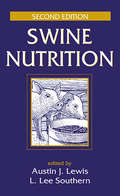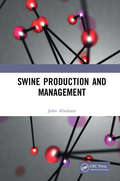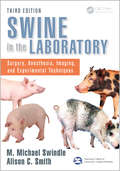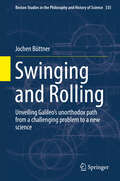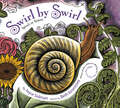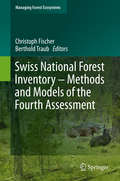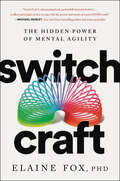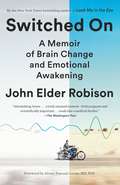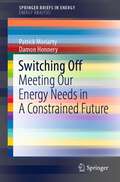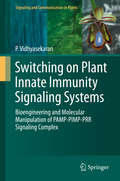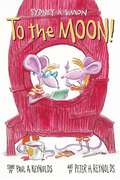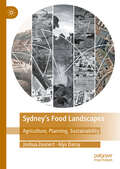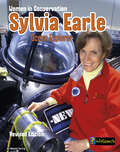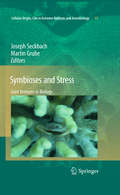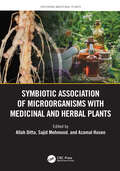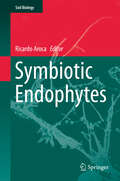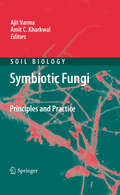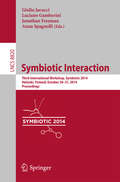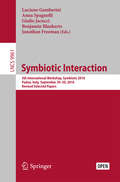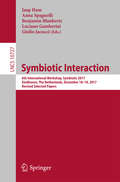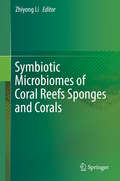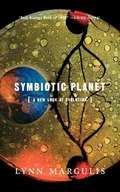- Table View
- List View
Swine Nutrition
by Austin J. Lewis L. Lee SouthernWith 42 chapters authored by leading international experts, Swine Nutrition: Second Edition is a comprehensive reference that covers all aspects of the nutrition of pigs. Content includes characteristics of swine and the swine industry with emphasis on the gastrointestinal tract; various classes of nutrients, how these nutrients are metabolized by swine, and the factors affecting their utilization; the practical aspects of swine nutrition from birth through gestation, lactation in sows, and the feeding of adult boars; and nutritional aspects of the various feedstuffs commonly fed to swine. Rounding the book is coverage of various techniques used in swine nutrition research.
Swine Production and Management
by John AbrahamThis book elaborately covers all topics of swine management like breeding, feeding, housing, health management and pork production technology.The book is well supported by a large number of illustrations and tables which makes the understanding of the text very simple and easy. It will be very useful for all students as well as professionals.Note: T& F does not sell or distribute the Hardback in India, Pakistan, Nepal, Bhutan, Bangladesh and Sri Lanka.
Swine in the Laboratory: Surgery, Anesthesia, Imaging, and Experimental Techniques, Third Edition
by M. Michael Swindle Alison C. SmithFor two decades, Swine in the Laboratory: Surgery, Anesthesia, and Experimental Techniques has been the most respected practical technical guide for medical and veterinary researchers using swine as experimental animals. Extensively updated and expanded since the publication of the second edition in 2007 and now sponsored by the American College of Laboratory Animal Medicine (ACLAM), it continues to be the most authoritative source of scientific and technical information on the use of domestic and miniature swine in research.Additions to the Third Edition Include: New chapters on toxicology, transgenics, cancer models, and necropsy techniques An overview of porcine models that were not included in the previous edition Updates to chapters on the various body systems Contributions from 25 new coauthors, as well as a new coeditor Significant expansions to the accompanying downloadable resources, including new normal data on farm and minipig breeds, videos on training swine and surgical procedures, updated anatomical imaging, and a colored histological atlas Detailed sections on anesthesia, analgesia, and perioperative care present the best current practices for using swine in experimental surgery. Providing a deepened reference of the most current information and best techniques in an increasingly popular field since the publication of the first edition, this book is a vital tool in conducting the best possible research using porcine models.
Swinging and Rolling: Unveiling Galileo's unorthodox path from a challenging problem to a new science (Boston Studies in the Philosophy and History of Science #335)
by Jochen BüttnerThis volume explores the reorganisation of knowledge taking place in the course of Galileo's research process extending over a period of more than thirty years, pursued within a network of exchanges with his contemporaries, and documented by a vast collection of research notes. It has revealed the challenging objects that motivated and shaped Galileo's thinking and closely followed the knowledge reorganization engendered by theses challenges. It has thus turned out, for example, that the problem of reducing the properties of pendulum motion to the laws governing naturally accelerated motion on inclined planes was the mainspring for the formation of Galileo's comprehensive theory of naturally accelerated motion.
Swirl by Swirl: Spirals in Nature
by Joyce SidmanSidman&’s lyrical poetry and Krommes&’ charming illustrations illuminate this intriguing shape found all throughout the universe. Young readers will enjoy discovering all of the different spirals in nature in this ebook edition. What makes the tiny snail shell so beautiful? Why does that shape occur in nature over and over again—in rushing rivers, in a flower bud, even inside your ear?With simplicity and grace, Sidman and Krommes not only reveal the many spirals in nature—from fiddleheads to elephant tusks, from crashing waves to spiraling galaxies—but also celebrate the beauty and usefulness of this fascinating shape.
Swiss National Forest Inventory – Methods and Models of the Fourth Assessment (Managing Forest Ecosystems #35)
by Christoph Fischer Berthold TraubThe Swiss National Forest Inventory (NFI) is a forest survey on national level which started in 1982 and has already reached its 5th survey cycle (NFI5). It can be characterized as a multisource and multipurpose inventory where information is mainly collected from terrestrial field surveys using permanent sample plots. In addition, data from aerial photography, GIS and forest service questionnaires are also included.The NFI's main objective is to provide statistically reliable and sound figures to stakeholders such as politicians, researchers, ecologists, forest service, timber industry, national and international organizations as well as to international projects such as the Forest Resources Assessment of the United Nations. For Switzerland, NFI results are typically reported on national and regional level.State of the art methods are applied in all fields of data collection which have been proven to be of international interest and have even served as a basis for other European NFIs. The presented methods are applicable to any sample based forest inventory around the globe.In 2001 the Swiss NFI published its methods for the first time. Since then, many methodological changes and improvements have been introduced. This book describes the complete set of methods and revisions since NFI2. It covers various topics ranging from inventory design and statistics to remote sensing, field survey methods and modelling. It also describes data quality concepts and the software framework used for data storage, statistical analysis and result presentation.
Switch Craft: The Hidden Power of Mental Agility
by Elaine Fox“In clear and accessible language, Elaine Fox shows how psychological science can help you to be agile in meeting challenges and to be flexible when things change. Drawing on personal experience and years of applying her research in coaching elite performance, she shows how adopting a few key skills can transform your life in profound ways. A book full of important insights.”—Mark Williams, Professor Emeritus of Clinical Psychology University and coauthor of the international bestseller Mindfulness: An Eight Week-Plan for Finding Peace in a Frantic World“Switch Craft is a fascinating book, packed full of practical advice on how to help you survive and thrive in an uncertain world. Written by a leading academic, it offers real insights in how to cope with the stresses and strains of a post-covid world.”—Michael Mosley, New York Times bestselling author and science journalistDiscover how expanding and improving your mental agility—your ability to flex your thoughts, feelings, and actions—can transform your life, bolster your resilience, and foster your zest for living.Endless self-help approaches claim to have the answer. It's important to be mindful, we are told, and to stay in the moment. Sometimes, we are advised to keep going no matter what, to be 'gritty'. Others tell us that adopting a 'growth mindset' is key.However, the truth is that there is no one-size-fits-all solution to dealing with life. Elaine Fox, one of the world's leading psychologists and performance coaches, has witnessed this time and again. In her work coaching top athletes, military leaders and business professionals, she has seen that it's the people who know how and when to switch between different approaches - people who have an agile mind - who achieve the best performance.Drawing on 25 years of scientific research, Fox shares with us her step-by-step guide to what she calls 'switchcraft': the set of skills we need to navigate a complex and uncertain world. Whether it's coping with a difficult boss, overcoming a fear, dealing with hyperactive children, resolving a dispute with a friend or making a difficult choice about where to live or what to do, switchcraft helps us thrive in any situation.Like your own personal life coach, Switch Craft shows you how to break out of a rigid mindset to restore your fulfilment, curiosity and zest for life.
Switched On: A Memoir of Brain Change and Emotional Awakening
by John Elder Robison Marcel Just Alvaro Pascual-LeonAn extraordinary memoir about the cutting-edge brain therapy that dramatically changed the life and mind of John Elder Robison, the New York Times bestselling author of Look Me in the EyeNAMED ONE OF THE BEST BOOKS OF THE YEAR BY THE WASHINGTON POST Imagine spending the first forty years of your life in darkness, blind to the emotions and social signals of other people. Then imagine that someone suddenly switches the lights on.It has long been assumed that people living with autism are born with the diminished ability to read the emotions of others, even as they feel emotion deeply. But what if we've been wrong all this time? What if that "missing" emotional insight was there all along, locked away and inaccessible in the mind? In 2007 John Elder Robison wrote the international bestseller Look Me in the Eye, a memoir about growing up with Asperger's syndrome. Amid the blaze of publicity that followed, he received a unique invitation: Would John like to take part in a study led by one of the world's foremost neuroscientists, who would use an experimental new brain therapy known as TMS, or transcranial magnetic stimulation, in an effort to understand and then address the issues at the heart of autism? Switched On is the extraordinary story of what happened next. Having spent forty years as a social outcast, misreading others' emotions or missing them completely, John is suddenly able to sense a powerful range of feelings in other people. However, this newfound insight brings unforeseen problems and serious questions. As the emotional ground shifts beneath his feet, John struggles with the very real possibility that choosing to diminish his disability might also mean sacrificing his unique gifts and even some of his closest relationships. Switched On is a real-life Flowers for Algernon, a fascinating and intimate window into what it means to be neurologically different, and what happens when the world as you know it is upended overnight. Praise for Switched On"An eye-opening book with a radical message . . . The transformations [Robison] undergoes throughout the book are astonishing--as foreign and overwhelming as if he woke up one morning with the visual range of a bee or the auditory prowess of a bat."--The New York Times "Astonishing, brave . . . reads like a medical thriller and keeps you wondering what will happen next . . . [Robison] takes readers for a ride through the thorny thickets of neuroscience and leaves us wanting more."--The Washington Post "Fascinating for its insights into Asperger's and research, this engrossing record will make readers reexamine their preconceptions about this syndrome and the future of brain manipulation."--Booklist"Like books by Andrew Solomon and Oliver Sacks, Switched On offers an opportunity to consider mental processes through a combination of powerful narrative and informative medical context."--BookPage "A mind-blowing book that will force you to ask deep questions about what is important in life. Would normalizing the brains of those who think differently reduce their motivation for great achievement?"--Temple Grandin, author of The Autistic Brain "At the heart of Switched On are fundamental questions of who we are, of where our identity resides, of difference and disability and free will, which are brought into sharp focus by Robison's lived experience."--Graeme Simsion, author of The Rosie Effect
Switchgrass
by Andrea MontiThe demand for renewable energies from biomass is growing steadily as policies are enacted to encourage such development and as industry increasingly sees an opportunity to develop bio-energy enterprises. Recent policy changes in the EU, USA and other countries are spurring interest in the cultivation of energy crops such as switchgrass. Switchgrass has gained and early lead in the race to find a biomass feedstock for energy production (and for the almost requisite need for bio-based products from such feedstocks). Switchgrass: A Valuable Biomass Crop for Energy provides a comprehensive guide to the biology, physiology, breeding, culture and conversion of switchgrass as well as highlighting various environmental, economic and social benefits. Considering this potential energy source, Switchgrass: A Valuable Biomass Crop for Energy brings together chapters from a range of experts in the field, including a foreword from Kenneth P. Vogel, to collect and present the environmental benefits and characteristics of this a crop with the potential to mitigate the risks of global warming by replacing fossil fuels. Including clear figures and tables to support discussions, Switchgrass: A Valuable Biomass Crop for Energy provides a solid reference for anyone with interest or investment in the development of bioenergy; researchers, policy makers and stakeholders will find this a key resource.
Switching Off: Meeting Our Energy Needs in A Constrained Future (SpringerBriefs in Energy)
by Patrick Moriarty Damon HonneryThe book is about global energy use, its past and present, and its increasingly uncertain future. It lists the various ecological problems facing our planet, not just climate change, and how their gravity has been underestimated. It briefly looks at the various solutions, apart from renewable energy, proposed for solving the problems our present energy use raises, including solar radiation management, carbon dioxide removal, nuclear energy, and energy efficiency. Renewable energy (RE) is seen by many as the panacea for a variety of environmental challenges, and with the New Green Deal, even as a means of accelerating economic growth. The book critically examines the prospects for RE. It concludes that although it is essential that the world shifts to RE, not only will the ecologically sustainable energy from all RE sources likely fall well short of even present global energy use, but the very short time frame left for effective action means that RE cannot be more than of minor help. Hence, deep energy reductions will be needed, especially in high-income OECD countries. The book uses an Earth Systems Science approach, which is necessary because of the interconnection between the various challenges our Earth faces. It aims to combine the latest findings from a diverse array of biophysical as well as socioeconomic sciences to uncover the increasingly constrained energy options we will encounter.
Switching on Plant Innate Immunity Signaling Systems
by P. VidhyasekaranThis book presents the ways and means to switch on plant immune signaling systems using PAMP-PIMP-PRR signaling complex for crop disease management. It also describes bioengineering approaches to develop transgenic plants expressing enhanced disease resistance using genes encoding PAMPs, PRRs and transcription factors and genes involved in generation of PIMPs/HAMPs. It also discusses recent commercial development of PAMP products to switch on plant innate immunity for crop disease management. These unique approaches have been described with more than 100 figures and illustrations and these would make this book attractive for researchers and students to buy this book.
Sydney & Simon: To the Moon! (Sydney & Simon #3)
by Paul A. ReynoldsEager to win a chance to meet a real-life astronaut, twin mice Sydney and Simon use STEAM thinking to create the best science project about the Moon The chance to meet astronaut Kris Kornfield is a dream come true for twins Sydney and Simon. But first they have to come up with the most creative project about the Earth&’s moon. While Sydney&’s work is all about the art, and Simon&’s is all about the data, neither seems creative enough to win the prize. But when they put their heads together, they incorporate S.T.E.A.M. thinking (Science, Technology, Engineering, Arts, Mathematics) and come up with a winning idea. The third installment in the Sydney & Simon series, this kid-friendly story makes science concepts accessible and exciting.
Sydney’s Food Landscapes: Agriculture, Planning, Sustainability
by Joshua Zeunert Alys DaroyThe story of Sydney’s metropolitan food landscapes is one of dramatic transformations of First Nations land amidst jostles for power and wealth. This book unearths Sydney's lost commercial agriculture since colonisation in 1788 to assess its fragile food futures. Richly illustrated, 270 images are encapsulated within 110 figures, including an array of original metropolitan-scale mappings. Discussion traverses the city’s diverse cultural influences, from Indigenous land management to British pastoralism, Chinese cultivation of Sydney’s “backyard vegetable garden” and southern European farming spawning billion-dollar empires. The region has further been shaped by a vast array of cultural and ideological factors and material practices, with relevance to planning, policy, ethics, geography, heritage, art, design and technology. This book is the first to bring Sydney’s disparate post-colonial food histories together in one volume to explore the dynamics and tensions between urban growth and food production. The relevance of Sydney’s food landscapes therefore extends far wider than the city itself, with implications for countless regions worldwide in a time of increasing climate and resource precarity.
Sylvia Earle: Ocean Explorer (Women in Conservation)
by Dennis FertigThis book takes an engaging look at the work of ground-breaking conservationist, Sylvia Earle, and her work to protect oceans and ocean life. It covers Earle's inspiration, her methods, findings, and the impact of her work.
Symbioses and Stress
by Joseph Seckbach Martin GrubeThis book centers on the question of how organisms in tight symbiotic associations cope with various types of abiotic and biotic stress. In its original sense, symbioses cover all kinds of interactions among unrelated organisms, whereas in a narrower concept, the term is often referred to as mutualism. Evolutionary biology recognizes symbiosis as an integrative process, and most fundamental evolutionary innovations arose from cooperative symbioses. Mutualisms contribute to stress tolerance, ecosystem stability, and evolutionary radiation of cooperating organisms. Modern eukaryotic cells are the result of the endosymbiotic union of prokaryotic ancestors as well as diverse exosymbiotic associations. This cooperative aggregation appears more successful than its independent parts.
Symbiosis: Cellular, Molecular, Medical and Evolutionary Aspects (Results and Problems in Cell Differentiation #69)
by Malgorzata KlocThis volume presents a comprehensive overview of the latest developments in symbiosis research. It covers molecular, organellar, cellular, immunologic, genetic and evolutionary aspects of symbiotic interactions in humans and other model systems. The book also highlights new approaches to interdisciplinary research and therapeutic applications. Symbiosis refers to any mutually beneficial interaction between different organisms. The symbiotic origin of cellular organelles and the exchange of genetic material between hosts and their bacterial and viral symbionts have helped shaped the current diversity of life. Recently, symbiosis has gained a new level of recognition, due to the realization that all organisms function as a holobiome and that any kind of interference with the hosts influences their symbionts and vice versa, and can have profound consequences for the survival of both. For example, in humans, the microbiome, i.e., the entirety of all the microorganisms living in association with the intestines, oral cavity, urogenital system and skin, is partially inherited during pregnancy and influences the maturation and functioning of the human immune system, protects against pathogens and regulates metabolism. Symbionts also regulate cancer development, wound healing, tissue regeneration and stem cell function. The medical applications of this new realization are vast and largely uncharted. The composition and robustness of human symbionts could make them a valuable diagnostic tool for predicting impending diseases, and the manipulation of symbionts could yield new strategies for the treatment of incurable diseases.
Symbiotic Association of Microorganisms with Medicinal and Herbal Plants (Exploring Medicinal Plants)
by Azamal Husen Allah Ditta Sajid MehmoodResearch establishes that symbiotic association of microbes with medicinal and herbal plants enhance the growth and accumulation of bioactive materials, and that species of microbes including bacterial and fungal species play a key role. Symbiotic Association of Microorganisms with Medicinal and Herbal Plants identifies the important symbiotic association between microbes and medicinal plants, including perspectives in improving bioactive ingredients for the synthesis and preparation of pharmaceutical drugs.Features Provides a comprehensive overview of symbiotic association of microorganisms with medicinal and herbal plants Discusses the impacts of symbiotic association on the diversity, growth and chemical components of the medicinal and herbal plants Elaborates opportunities and future challenges regarding the understanding of symbiotic association between microbes and medicinal plants A volume in the Exploring Medicinal Plants series, this book provides exciting information in a structured manner for scientists, researchers, and students working in various fields including medicinal plants, microbiology, economic botany, chemistry, biotechnology, pharmacognosy, and pharmaceuticals.
Symbiotic Endophytes
by Ricardo ArocaThis Soil Biology volume examines our current understanding of the mechanisms involved in the beneficial effects transferred to plants by endophytes such as rhizobial, actinorhizal, arbuscular mycorrhizal symbionts and yeasts. Topics presented include how symbiosis starts on the molecular level; chemical signaling in mycorrhizal symbiosis; genomic and functional diversity of endophytes; nitrogen fixation; nutrient uptake and cycling; as well as plant protection against various stress conditions. Further, the use of beneficial microorganisms as biopesticides is discussed, particularly the application of Plant Growth Promoter Rhizobacteria (PGPR) in agriculture with the aim to increase yields.
Symbiotic Fungi
by Amit C. Kharkwal Ajit VarmaSymbiotic Fungi - Principles and Practice presents current protocols for the study of symbiotic fungi and their interactions with plant roots, such as techniques for analyzing nutrient transfer, ecological restoration, microbial communication, and mycorrhizal bioassays, AM inoculum procedures and mushroom technology. The protocols offer practical solutions for researchers and students involved in the study of symbiotic microorganisms. The volume will be of great use for basic research, biotechnological applications, and the development of commercial products.
Symbiotic Interaction
by Giulio Jacucci Luciano Gamberini Jonathan Freeman Anna SpagnolliThis book constitutes the proceedings of the third International Workshop on Symbiotic Interaction, Symbiotic 2014, held in Helsinki, Finland, in October 2014. The 8 full papers and 5 short papers presented in this volume were carefully reviewed and selected from 16 submissions. They are organized in topical sections named: definitions of symbiotic interaction; reviews of implicit interaction; example applications; experimenting with users; and demos and posters.
Symbiotic Interaction
by Giulio Jacucci Luciano Gamberini Jonathan Freeman Anna Spagnolli Benjamin BlankertzThis book constitutes the proceedings of the 4th International Workshop on Symbiotic Interaction, Symbiotic 2015, held in Berlin, Germany, in October 2015. The 11 full papers and 8 short papers presented in this volume were carefully reviewed and selected from 23 submissions. The papers present an overview of the symbiotic relationships between humans and computers as well as novel advancements. The idea of symbiotic systems put forward in this workshop capitalises on the computers' ability to implicitly detect the users goals and psycho-physiological states and thereby enhancing human-computer interaction (HCI). A special focus of this year's Symbiotic Workshop will be on physiological computing approaches, e. g. using brain-computer interface (BCI) technology.
Symbiotic Interaction: 4th International Workshop, Symbiotic 2015, Berlin, Germany, October 7-8, 2015, Proceedings (Theoretical Computer Science and General Issues #9359)
by Giulio Jacucci Luciano Gamberini Anna Spagnolli Benjamin Blankertz Jaap HamThis book constitutes the proceedings of the 6th International Workshop on Symbiotic Interaction, Symbiotic 2017, held in Eindhoven, The Netherlands in December 2017. The 8 full papers, 2 short papers and 1 report presented in this volume were carefully reviewed and selected from 23 submissions. The International Workshop on Symbiotic Interaction is the primary venue for presenting scientific work dealing with the symbiotic relationships between humans and computers and for discussing the nature and implications of such relationships.
Symbiotic Microbiomes of Coral Reefs Sponges and Corals
by Zhiyong LiThis book focuses on the symbiotic microbiomes of invertebrates in coral reefs, especially sponges and corals. It provides in-depth and up-to-date reviews on the microbial structure and diversity, metabolism and function, symbiosis and coevolution, environment and adaption, and bioactive potentials. Meanwhile, the future perspectives will be discussed according to the existing problems and the development trend. This book will be of particular interest to the professionals in marine ecology, marine biotechnology, as well as medicinal chemists and molecular biologists.
Symbiotic Planet: A New Look At Evolution
by Lynn MargulisAuthor shows that symbiosis, which simply means members of different species living in physical contact with one another, is crucial to the origins of evolutionary novelty.
